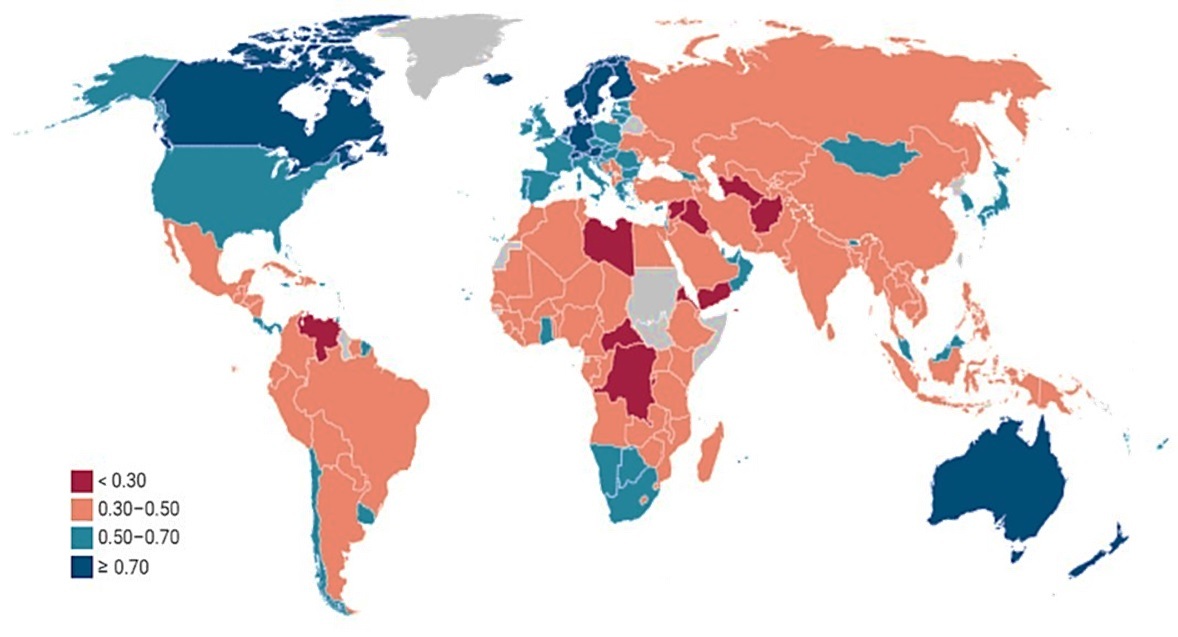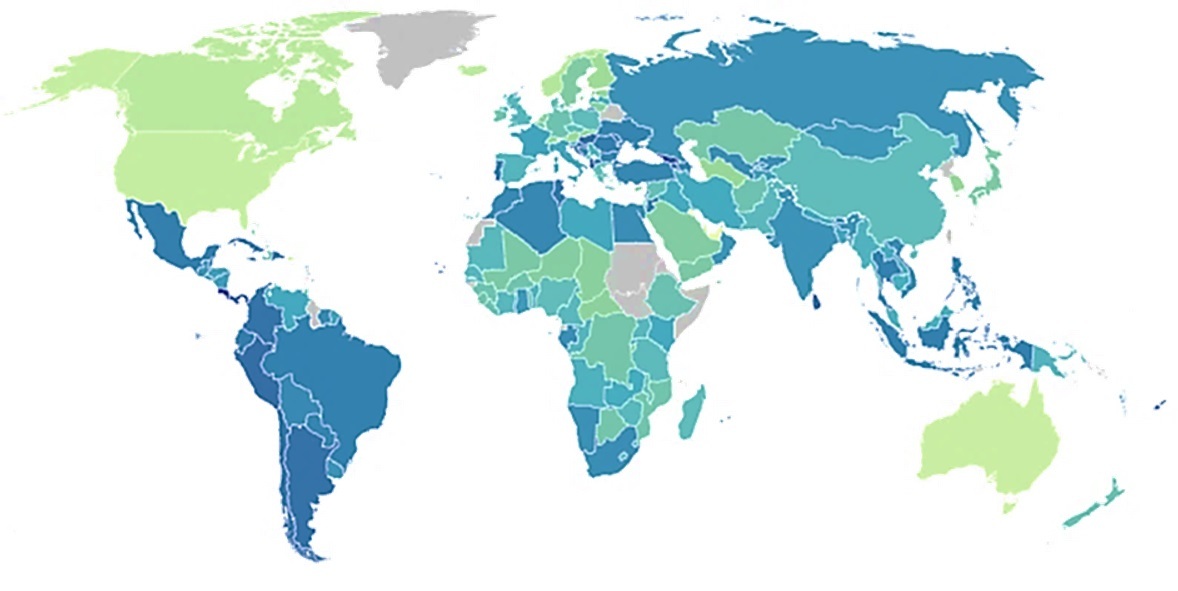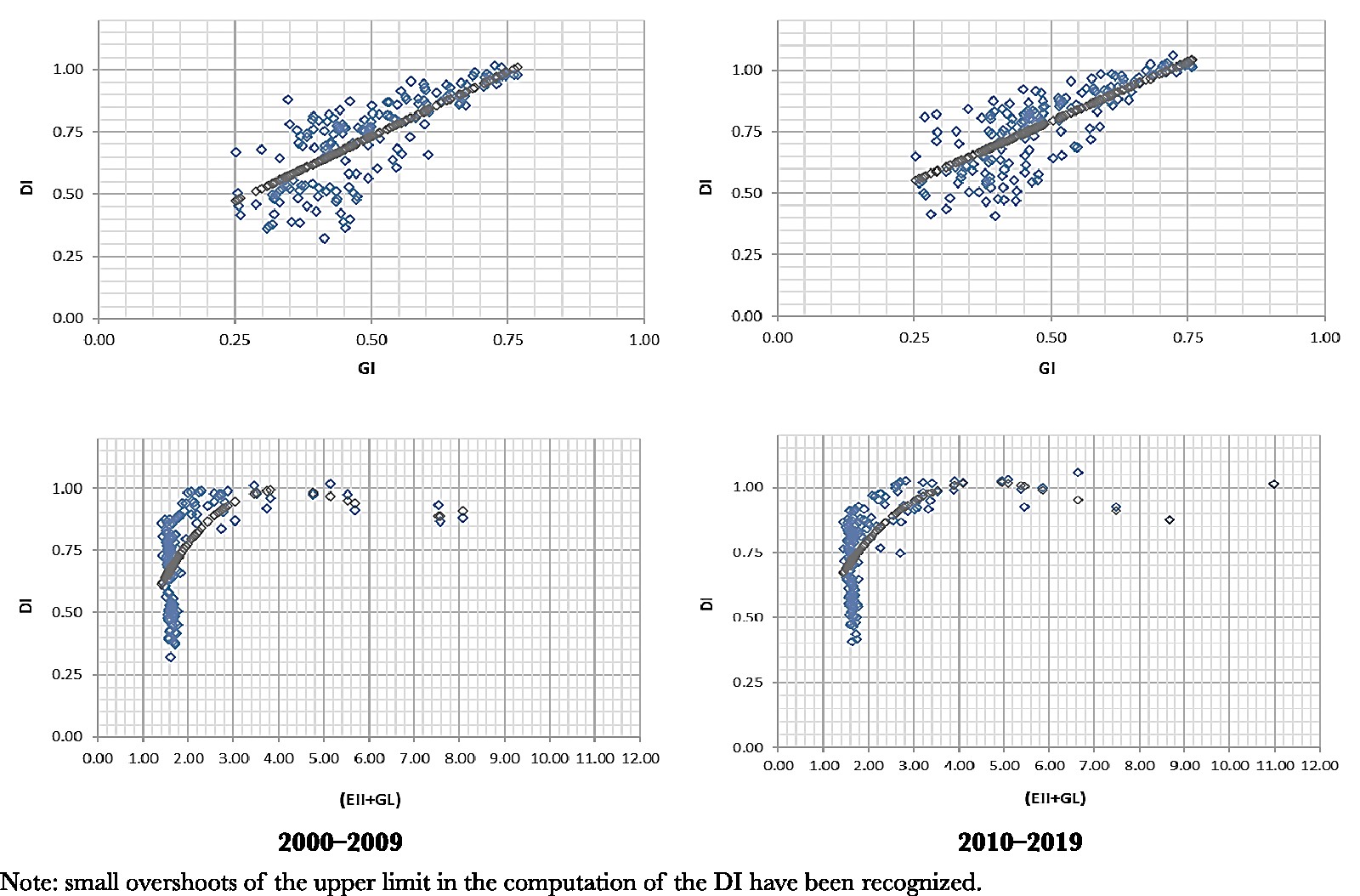Scopus Indexed
Scopus Indexed
Article Peer-Reviewed
The Sustainable Development Index: An Integration of the Ecological Framework Considering the Governance-development Nexus
University of Perugia, Umbria, Italy
Academic Editor:
Received: 6 July 2024 Accepted: 12 September 2024 Published: 1 November 2024
This article is part of the Special Issue Economic Growth and Environmental Degradation.
Abstract
This paper aims to enhance the formulation of the Sustainable Development Index (SDI) by introducing a further correction term, governance lack (GL) index, in additional to the ecological impact index (EII). The GL considers a country’s governance lack by calculating a governance index (GI) with the World Governance Indicators (WGIs) starting from 1996. The SDI(g) retains the original formula of the SDI, thus remaining an indicator of strong environmental sustainability but adequately considering in its formulation the differences significant in countries’ governance climate. Finally, graphical relationships between DI and GI, and DI and (EII + GL) are shown, and the existence of these relationships are tested with WLS and nonparametric regressions. Our findings show that significant differences in country ranking were found; the graphical relationships are empirically proven; and countries with a worse GI have been further penalized in the SDI(g) ranking.
Figures in this Article
Would you like to reuse the images? Contact the journal editorial office to obtain high-quality versions.
Keywords
Copyright © 2024
Scalamonti. This article is distributed under the terms of the Creative Commons Attribution License (CC BY 4.0), which permits unrestricted use and distribution provided that the original work is properly cited.
Funding
This research received no specific grant from any funding agency in the public, commercial, or not-for-profit sectors.
Cite this Article
Scalamonti, F. (2024). The Sustainable Development Index: An Integration of the Ecological Framework Considering the Governance-development Nexus. Highlights of Sustainability, 3(4), 354–373. https://doi.org/10.54175/hsustain3040020
References
1.
Hickel, J. (2020). The sustainable development index: Measuring the ecological efficiency of human development in the anthropocene. Ecological Economics, 167, 106331. https://doi.org/10.1016/j.ecolecon.2019.05.011
2.
Pelenc, J., Lompo, M. K., Ballet, J., & Dubois, J. L. (2013). Sustainable Human Development and the Capability Approach: Integrating Environment, Responsibility and Collective Agency. Journal of Human Development and Capabilities, 14(1), 77–94. https://doi.org/10.1080/19452829.2012.747491
3.
Hirai, T. (2017). The Creation of the Human Development Approach. Palgrave Macmillan.
4.
McGillivray, M. (2005). Measuring non-economic well-being achievement. Review of Income and Wealth, 51(2), 337–364. https://doi.org/10.1111/j.1475-4991.2005.00157.x
5.
Kovacevic, M. (2010). Review of HDI critiques and potential improvements (Human development research paper 2010/33). UNDP.
6.
Porter, M., Stern, S., & Green, M. (2013). Social Progress Index Report. Societal Progress Imperative.
7.
Sen, A. (1985). Commodities and Capabilities. North-Holland.
8.
North, D. (1990). Institutions, Institutional Change, and Economic Performance. Cambridge University Press.
9.
Stiglitz, J., Sen, A., & Fitoussi, J. (2009). The measurement of economic performance and social progress revisited: Reflections and overview (OFCE–Document de Travail, No. 33, pp. 1–64). https://www.ofce.sciences-po.fr/pdf/dtravail/WP2009-33.pdf?simple=True (accessed 8 June 2024).
10.
Bruni, L., & Zamagni, S. (2004). Civil economy: Efficiency, equity, and public happiness. Il Mulino.
11.
Jones, M. (2006). The American Pursuit of Unhappiness: Gross National Happiness and Well-being (GNH Index or GNW Index) – A New Socioeconomic Development Policy Solution (IIM-Policy White Paper). International Institute of Management. https://iim-edu.org/grossnationalhappiness/index.htm (accessed 8 June 2024).
12.
Ura, K., Alkire, S., Zangmo, T., & Wangdi, K. (2012). An Extensive Analysis of GNH Index. The Center for Bhutan Studies.
13.
Tideman, S. G. (2016). Gross National Happiness: Lessons for sustainable leadership. South Asian Journal of Global Business Research, 5(2), 190–213. https://doi.org/10.1108/sajgbr-12-2014-0096
14.
Dasgupta, P. (2024). Economic Growth in the Anthropocene. Capitalism & Society, 18(1), 1–6.
15.
Hueting, R. (1993). Calculating a Sustainable National Income: A Practical Solution for a Theoretical Dilemma. In A. Franz & C. Stahmer (Eds.), Approaches to Environmental Accounting. Contributions to Economics. Physica-Verlag.
16.
Scalamonti, F. (2021). Bottled Water Industry: a quantitative study approach. Italian Review of Agricultural Economics, 76(2), 31–44. https://doi.org/10.36253/rea-13095
17.
Kaufmann, D., Kraay, A., & Zoido, P. (1999). Governance Matters. SSRN. https://ssrn.com/abstract=188568 (accessed 8 June 2024).
18.
Henisz, W. (2000). The Institutional Environment for Economic Growth. Economics and Politics, 12(1), 1–31. https://doi.org/10.1111/1468-0343.00066
19.
Kaufmann, D., & Kraay, A. (2002). Growth without Governance. Economía, 3(1), 169–229. https://doi.org/10.1353/eco.2002.0016
20.
Bigerna, S., Bollino, C. A., & Polinori, P. (2022). Convergence of ecological footprint and sustainable policy options. Journal of Policy Modeling, 44(3), 564–577. https://doi.org/10.1016/j.jpolmod.2022.07.001
21.
Acemoglu, D., & Robinson, J. A. (2006). Economic origins of dictatorship and democracy. Cambridge University Press.
22.
Acemoglu, D., & Robinson, J. A. (2008). Persistence of Power, Elites, and Institutions. American Economic Review, 98(1), 267–293. https://doi.org/10.1257/aer.98.1.267
23.
Acemoglu, D., Johnson, S., Robinson, J. A., & Yared, P. (2008). Income and Democracy. American Economic Review, 98(3), 808–842. https://doi.org/10.1257/aer.98.3.808
24.
Baland, J.M, Moene, K. O., & Robinson, J. A. (2010). Governance and Development. In D. Rodrik & M. Rosenzweig (Eds.), Handbook of Development Economics (Vol. 5). Elsevier.
25.
Togtokh, C., & Gaffney, O. (5 November 2010). Human Sustainable Development Index. Our World, United Nations University. https://ourworld.unu.edu/en/the-2010-human-sustainable-development-index (accessed 8 June 2024).
26.
Pineda, J. (2012). Sustainability and Human Development: A Proposal for a Sustainability Adjusted Human Development Index. Theoretical and Practical Research in Economic Fields, 3(2), 71–98.
27.
Türe, C. (2013). A methodology to analyse the relations of ecological footprint corresponding with human development index: eco-sustainable human development index. International Journal of Sustainable Development & World Ecology, 20(1), 9–19. https://doi.org/10.1080/13504509.2012.751562
28.
Bravo, G. (2014). The Human Sustainable Development Index: New calculations and a first critical analysis. Ecological Indicators, 37, 145–150. https://doi.org/10.1016/j.ecolind.2013.10.020
29.
Ranis, G., & Stewart, F. (2012). Success and Failure in Human Development, 1970–2007. Journal of Human Development and Capabilities, 13(2), 167–195. https://doi.org/10.1080/19452829.2011.645026
30.
Biggeri, M., & Mauro, V. (2018). Towards a more sustainable human development index: Integrating the environment and freedom. Ecological Indicators, 91, 220–231. https://doi.org/10.1016/j.ecolind.2018.03.045
31.
Leiwakabessy, E., & Amaluddin, A. (2020). A Modified Human Development Index: Democracy and Economic Growth in Indonesia. Humanities and Social Sciences Reviews, 8(2), 732–743. https://doi.org/10.18510/hssr.2020.8282
32.
Silva, R., & Ferreira-Lopes, A. (2013). A Regional Development Index for Portugal. Social Indicators Research, 118(3), 1055–1085. https://doi.org/10.1007/s11205-013-0455-z
33.
Ostrom, E. (2010). Beyond markets and states: polycentric governance of complex economic systems. American Economic Review, 100(3), 641–672. https://doi.org/10.1257/aer.100.3.64
34.
Luciani, F. (2022). Preservation of the Common Good. Bioeconomics Review, 5(1).
35.
Sachs, J., Schmidt-Traub, G., Kroll, C., Lafortune, G., & Fuller, G. (2019). Sustainable Development Report: Transformations to Achieve the Sustainable Development Goals. Bertelsmann Stiftung and Sustainable Development Solutions Network.
36.
Monkelbaan, J. (Ed.). (2019). Governance for the Sustainable Development Goals. Palgrave Macmillan.
37.
Van Zanten, J. A., & Van Tulder, R. (2021). Towards nexus-based governance: defining interactions between economic activities and Sustainable Development Goals (SDGs). International Journal of Sustainable Development & World Ecology, 28(3), 210–226. https://doi.org/10.1080/13504509.2020.1768452
38.
Chiappero-Martinetti, E., Von Jacobi, N., & Signorelli, M. (2015). Human Development and Economic Growth. In J. Hölscher & H. Tomann (Eds.), Palgrave Dictionary of Emerging Markets and Transition Economics. Palgrave Macmillan.
39.
Acemoglu, D., & Robinson, J. A. (2012). Why nations fail. Crown Publishing.
40.
Putnam, R., Leonardi, R., & Nanetti, R.Y. (Eds.). (1993). Making democracy work. Princeton University Press.
41.
Hall, R., & Jones, C. (1999). Why Do Some Countries Produce So Much More Output per Worker than Others? The Quarterly Journal of Economics, 114(1), 83–116. https://doi.org/10.1162/003355399555954
42.
Guiso, L., Sapienza, P., & Zingales, L. (2016). Long-term persistence. Journal of the European Economic Association, 14(6), 1401–1436. https://doi.org/10.1111/jeea.12177
43.
Scalamonti, F. (2021). The transition of the southern economies of Mediterranean Sea: The macroeconomic framework and the determinants of foreign investments. Industry–Review of Industrial Economics and Policy, 42(3), 533–578. https://doi.org/10.1430/98711
44.
Scalamonti, F. (2023). The “Africa Rising”: An Empirical Analysis of the Determinants of Per-Capita Growth. Qeios. https://doi.org/10.32388/2U1RS5.9
45.
Scalamonti, F. (2024). An integrated theoretical framework of firms’ entry modes in emerging and developing economies: evidence from African markets. SSRN. https://doi.org/10.2139/ssrn.4737937
46.
Scalamonti, F. (2024). The foreign investments-growth nexus in underdeveloped countries: the state-of-art of research analysing a selected and recent empirical literature (2020–2022). Technological Forecasting and Social Change, 198, 122933. https://doi.org/10.1016/j.techfore.2023.122933
47.
Ranis, G., Stewart, F., & Samman, E. (2006). Human Development: Beyond the Human Development Index. Journal of Human Development, 7(3), 323–358. https://doi.org/10.1080/14649880600815917
48.
Rock, M. (2009). Has Democracy Slowed Growth in Asia? World Development, 37(5), 941–952. https://doi.org/10.1016/j.worlddev.2008.09.002
49.
Knutsen, C. (2011). Which democracies prosper? Electoral rules, form of government and economic growth. Electoral Studies, 30(1), 83–90. https://doi.org/10.1016/j.electstud.2010.09.006
50.
You, J. (2015). Democracy, inequality, and corruption: Korea, Taiwan and the Philippines compared. Cambridge University Press.
51.
Gerring, J., Thacker, S., & Alfaro, R. (2012). Democracy and Human Development. The Journal of Politics, 74(1), 1–17. https://doi.org/10.1017/s0022381611001113
52.
Aisen, A., & Veiga, F. (2013). How does political instability affect economic growth? European Journal of Political Economy, 29, 151–167. https://doi.org/10.1016/j.ejpoleco.2012.11.001
53.
Salas-Bourgoin, M. (2014). A proposal for a modified Human Development Index. CEPAL Review, 112, 29–44. https://doi.org/10.18356/ea3f94ea-en
54.
Rachdi, H., & Saidi, H. (2015). Democracy and Economic Growth: Evidence in MENA Countries. Social and Behavioral Sciences (Procedia), 191, 616–621. https://doi.org/10.1016/j.sbspro.2015.04.644
55.
Saha, S., & Zhang, Z. (2017). Democracy-growth nexus and its interaction effect on human development: A cross-national analysis. Economic Modelling, 63, 304–310. https://doi.org/10.1016/j.econmod.2017.02.021
56.
Biermann, F., & Rakhyun, E. K. (Eds.). (2020). Architectures of Earth System Governance. Cambridge University Press.
57.
Kaufmann, D., Kraay, A., & Mastruzzi, M. (2011). The Worldwide Governance Indicators: Methodology and Analytical Issues. Hague Journal on the Rule of Law, 3(02), 220–246. https://doi.org/10.1017/s1876404511200046
58.
Scalamonti, F. (2024). SDI(g)_and_GI_(1996-2019) (Version 5) [Dataset]. Mendeley. https://doi.org/10.17632/247h9zc32d.5
59.
Mazzanti, M., & Musolesi, A. (2013). The heterogeneity of carbon Kuznets curves for advanced countries: comparing homogeneous, heterogeneous and shrinkage/Bayesian estimators. Applied Economics, 45(27), 3827–3842. https://doi.org/10.1080/00036846.2012.734597
60.
Azomahou, T. T., Goedhuys, M., & Nguyen Van, P. (2015). A Structural Nonparametric Reappraisal of the CO2 Emissions: Income Relationship. Revue Économique, 67(1), 167–174. https://doi.org/10.3917/reco.pr2.0061
61.
Cleveland, W. S. (1979). Robust Locally Weighted Regression and Smoothing Scatterplots. Journal of the American Statistical Association, 74(368), 829–836. https://doi.org/10.1080/01621459.1979.10481038
62.
Shafik, N. (1994). Economic Development and Environmental Quality: An Econometric Analysis. Oxford Economic Papers, 46(1), 757–773. https://doi.org/10.1093/oep/46.supplement_1.757
63.
Grossman, G. M., & Krueger, A. B. (1995). Economic Growth and the Environment. The Quarterly Journal of Economics, 110(2), 353–377. https://doi.org/10.2307/2118443
64.
Frankel, J. (2003). The Environment and Globalization (Working Paper 10090). NBER. https://doi.org/10.3386/w10090
65.
Dinda, S. (2005). A theoretical basis for the environmental Kuznets curve. Ecological Economics, 53(3), 403–413. https://doi.org/10.1016/j.ecolecon.2004.10.007
66.
Bagliani, M., Bravo, G., & Dalmazzone, S. (2008). A consumption-based approach to environmental Kuznets curves using the ecological footprint indicator. Ecological Economics, 65(3), 650–661. https://doi.org/10.1016/j.ecolecon.2008.01.010
67.
Webber, D. J., & Allen, D. O. (2010). Environmental Kuznets curves: mess or meaning? International Journal of Sustainable Development and World Ecology, 17(3), 198–207. https://doi.org/10.1080/13504501003787638
68.
Halkos, G. E., & Tsionas, E. G. (2001). Environmental Kuznets curves: Bayesian evidence from switching regime models. Energy Economics, 23(2), 191–210. https://doi.org/10.1016/S0140-9883(00)00063-3
69.
Halkos, G. E., & Bampatsou, C. (2019). Economic growth and environmental degradation: a conditional nonparametric frontier analysis. Environmental Economics and Policy Studies, 21(2), 325–347. https://doi.org/10.1007/s10018-018-0232-y
70.
Herrmann-Pillath, C. (2011). The evolutionary approach to entropy: Reconciling Georgescu-Roegen’s natural philosophy with the maximum entropy framework. Ecological Economics, 70(4), 606–616. https://doi.org/10.1016/j.ecolecon.2010.11.021
71.
Kümmel, R. (2016). The Impact of Entropy Production and Emission Mitigation on Economic Growth. Entropy, 18(3), 75. https://doi.org/10.3390/e18030075
72.
Kümmel, R., & Lindenberger, D. (2020). Energy, Entropy, Constraints, and Creativity in Economic Growth and Crises. Entropy, 22(10), 1156. https://doi.org/10.3390/e22101156
73.
Focardi, S. (2024). Changing climate: The need for sustainable development. Betti.
74.
Brock, W. A., & Taylor, M. S. (2010). The Green Solow model. Journal of Economic Growth, 15(2), 127–153. https://doi.org/10.1007/s10887-010-9051-0
75.
Hickel, J., & Kallis, G. (2019). Is green growth possible? New Political Economy, 25(4), 469–486. https://doi.org/10.1080/13563467.2019.1598964
76.
Atalla, T., Bigerna, S., Bollino, C. A., & Polinori, P. (2018). An alternative assessment of global climate policies. Journal of Policy Modeling, 40(6), 1272–1289. https://doi.org/10.1016/j.jpolmod.2018.02.003
77.
Rodrik, D. (2011). The globalization paradox. Norton.
78.
Lakner, C., & Milanovic, B. (2016). Global Income Distribution: From the Fall of the Berlin Wall to the Great Recession. The World Bank Economic Review, 30(2), 203–232. https://doi.org/10.1093/wber/lhv039
79.
Hickel, J. (2017). The Divide: A Brief Guide to Global Inequality and Its Solutions. Penguin.
80.
Stiglitz, J. E. (2018). Globalization and its discontents revisited. Norton.
81.
Mariotti, S. (2024). “Win-lose” globalization and the weaponization of economic policies by nation-states. Critical Perspectives on International Business, 1–22. https://doi.org/10.1108/cpoib-09-2023-0089
82.
Van Bergeijk, P. (2013). Earth Economics: An Introduction to Demand Management, Long-Run Growth and Global Economic Governance. Edward Elgar.
83.
Scalamonti, F. (2024). Societal change and progress in an evolving world: beyond the maximization logic and to the adoption of satisficing choices for sustainable development. SSRN. https://doi.org/10.2139/ssrn.4726054
84.
Nazir, S., & Capocchi, A. (Eds.). (2024). Sustainability Reporting Practices and the Circular Economy: Analysis and Integrated Strategies. Palgrave Macmillan.
85.
Bollino, C. A., & Polinori, P. (2011). Sustainability: Will There Be the Will and the Means? In F. P. Sioshansi (Ed.), Energy, Sustainability and the Environment. Butterworth-Heinemann.
86.
Nordhaus, W., Goldberg, P., Barrett, S., Wilkinson, S., & Oxtoby, D. (2021). Steps Toward International Climate Governance. Bulletin of the American Academy of Arts and Sciences, 74(3), 16–29.
87.
Markandya, A., Labandeira, X., & Ramos, A. (2015). Policy Instruments to Foster Energy Efficiency. In A. Ansuategi, J. Delgado, & I. Galarraga (Eds.), Green Energy and Efficiency: Green Energy and Technology (pp. 93–110). Palgrave Macmillan.
88.
Barrage, L., & Nordhaus, W. (2024). Policies, projections, and the social cost of carbon: Results from the DICE-2023 model. Proceedings of the National Academy of Sciences, 121(13), e2312030121. https://doi.org/10.1073/pnas.2312030121
89.
Acemoglu, D., Aghion, P., Bursztyn, L., & Hemous, D. (2012). The Environment and Directed Technical Change. American Economic Review, 102(1), 131–166. https://doi.org/10.1257/aer.102.1.131
90.
Nyborg, K., Anderies, J. M., Dannenberg, A., Lindahl, T., Schill, C., Schlüter, M., et al., (2016). Social norms as solutions. Science, 354(6308), 42–43. https://doi.org/10.1126/science.aaf8317
91.
Otto, I. M., Donges, J. F., Cremades, R., Bhowmik, A., Hewitt, R. J., Lucht, W., et al., (2020). Social tipping dynamics for stabilizing Earth’s climate by 2050. Proceedings of the National Academy of Sciences, 117(5), 2354–2365. https://doi.org/10.1073/pnas.1900577117
92.
Van der Ploeg, F., & Venables, A. J. (2022). Radical climate policies. University of Oxford.
93.
O’Neill, D. W., Fanning, A. L., Lamb, W. F., & Steinberger, J. K. (2018). A good life for all within planetary boundaries. Nature Sustainability, 1(2), 88–95. https://doi.org/10.1038/s41893-018-0021-4
94.
Hickel, J. (2018). Is it possible to achieve a good life for all within planetary boundaries? Third World Quarterly, 40(1), 18–35. https://doi.org/10.1080/01436597.2018.1535895
95.
Martínez Franzoni, J., & Sánchez-Ancochea, D. (2018). The Quest for Universal Social Policy in the South: Actors, Ideas and Architectures. Cambridge University Press.
96.
Hickel, J. (2019). Degrowth: a theory of radical abundance. Real-world Economics Review, 87(19), 54–68.
97.
Fanning, A., & Hickel, J. (2023). Compensation for atmospheric appropriation. Nature Sustainability, 6, 1077–1086. https://doi.org/10.1038/s41893-023-01130-8
Metrics
Loading...
Journal Menu
Journal Contact
Highlights of Sustainability
Editorial Office
Highlights of Science
Avenida Madrid, 189-195, 3-3
08014 Barcelona, Spain
08014 Barcelona, Spain
Cathy Wang
Managing Editor



